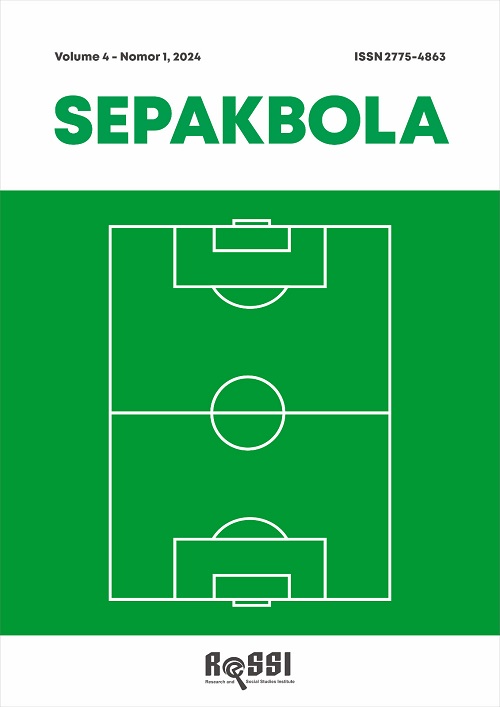Pengaruh latihan passing bervariasi terhadap akurasi passing siswa sekolah sepakbola Persisac kelompok usia 10-12 tahun
DOI:
https://doi.org/10.33292/sepakbola.v2i1.146Keywords:
Sepakbola, Variasi Passing, Ketepatan AkurasiAbstract
Tujuan dari penelitian ini adalah untuk mengetahui ketepatan akurasi passing setelah diberikan treatment latihan passing bervariasi. Dalam penelitian yang sudahdilakukan diperoleh hasil yang menggambarkan bahwa kemampuan passing anak-anak SSB Persisac Usia 10-12 tahun ada peningkatan yang signifikan setelah diberikan treatment passing bervariasi.Penelitian ini menggunakan pendekatan kuantitatif atau angka karena penelitian yang dilakukan adalah jenis penelitian eksperimen sehingga analisisnya berdasarkan angka dengan menggunakan analisis statistik, yaitu kegiatan penelitian yang di awali dengan tes awal lalu memberikan perlakuan dan diakhiri dengan tes untuk di uji kebenaranya. Instrumen penelitian yang digunakan dalam penelitian ini adalah tes ketrampilan bermain sepakbola yaitu gawang ukuran kecil berbentuk bidang dengan lebar 1,5 m dan panjang 0,5 m dengan jarak penendang 10 m dengan batas garis. Saran peneliti, Variasi latihan merupakan suatu cara yang baik untuk menanamkan kebiasaan-kebiasaan tertentu di dan bertujuan untuk memperoleh ketepatan passing yang akurat. Variasi latihan dilakukan secara berulang-ulang untuk suatu teknik yang sama dalam meningkatkan kemampuan serta akurasi untuk melakukan passing yang akurat.
Â
The effect of varying passing exercises on the passing accuracy of Persisac football school students aged 10-12 years
Â
Abstract: This study aims to determine the effect of various passing exercises on the passing accuracy of Persisac Football School players aged 10-12 years. This type of research is quasi-experimental, using a quantitative approach. The design of this study was a Randomized Control Group Pretest-posttest Design. The sampling technique in this study was a total sampling of 20 people. The instrument used was a ball kick skill test, with the validity of the test being 0.812 and the reliability being 0.856. Data analysis in this study used parametric statistics with intergroup t-test analysis. The results showed that there was an increase in the positive and significant effect of various passing exercises on the accuracy of passing at the Persisac Football School in the 10-12 years age group indicated by the results of the t value < 0.05 and the results of the analysis of the effect which gave an increase of 15.57%. The conclusion of this study is that there is a significant increase in varying passing exercises on the accuracy of passing at the Persisac Soccer School in the 10-12 years age group. Suggestions for coaches and players in an effort to improve the results of good passing techniques can use a varied passing training program as one way to facilitate mastery of the techniques learned.
References
Abid, W. M. El, Purnomo, E., & Kresnadi, H. (2013). Pengaruh latihan sasaran menggunakan ban bekas terhadap hasil shooting permainan sepakbola siswa Hidayatul Muhsinin. Jurnal Pendidikan Dan Pembelajaran Khatulistiwa, 2(12). https://doi.org/10.26418/jppk.v2i12.4038
Anam, K. (2013). Pengembangan latihan ketepatan tendangan dalam sepakbola untuk anak kelompok umur 13-14 tahun. Jurnal Media Ilmu Keolahragaan Indonesia, 3(2), 78–88. https://doi.org/10.15294/miki.v3i2.4377
Anam, K., Irawan, F. A., & Nurrachmad, L. (2019). Pengaruh metode latihan dan koordinasi mata-kaki terhadap ketepatan tendangan jarak jauh. Media Ilmu Keolahragaan Indonesia, 8(2), 57–62. https://doi.org/10.15294/miki.v8i2.17184
Anam, K., Subiyono, H. S., & Rahman, M. A. (2019). Profile of physical conditions from UNNES Football Club at Liga Mahasiswa Piala MENPORA 2019. Proceedings of the 5th International Conference on Physical Education, Sport, and Health (ACPES 2019), 77–81. https://doi.org/10.2991/acpes-19.2019.17
Augustus, S., Mundy, P., & Smith, N. (2017). Support leg action can contribute to maximal instep soccer kick performance: an intervention study. Journal of Sports Sciences, 35(1), 89–98. https://doi.org/10.1080/02640414.2016.1156728
Huijgen, B. C. H., Elferink-Gemser, M. T., Ali, A., & Visscher, C. (2013). Soccer skill development in talented players. International Journal of Sports Medicine, 34(8), 720–726. https://doi.org/10.1055/S-0032-1323781
Kellis, E., Katis, A., & Gissis, I. (2004). Knee biomechanics of the support leg in soccer kicks from three angles of approach. Medicine and Science in Sports and Exercise, 36(6), 1017–1028. https://doi.org/10.1249/01.MSS.0000128147.01979.31
Maly, T., Sugimoto, D., Izovska, J., Zahalka, F., & Mala, L. (2018). Effect of muscular strength, asymmetries and fatigue on kicking performance in soccer players. International Journal of Sports Medicine, 39(04), 297–303. https://doi.org/10.1055/s-0043-123648
Njororai, W. W. S. (2013). Analysis of goals scored in the 2010 world cup soccer tournament held in South Africa. Journal of Physical Education and Sport, 13(1), 6–13. https://doi.org/10.7752/jpes.2013.01002
Paixão, P., Sampaio, J., Almeida, C. H., & Duarte, R. (2017). How does match status affects the passing sequences of top-level European soccer teams? Http://Dx.Doi.Org/10.1080/24748668.2015.11868789, 15(1), 229–240. https://doi.org/10.1080/24748668.2015.11868789
Prahastara, P., & Sugiyanto, F. (2021). Pengaruh metode latihan dan agility terhadap keterampilan sepakbola. Sepakbola, 1(1), 23–31. https://doi.org/10.33292/sepakbola.v1i1.94
Instruksi Presiden Republik Indonesia Nomor 3 Tahun 2019 tentang percepatan pembangunan persepakbolaan nasional, (2019). https://peraturan.bpk.go.id/Home/Details/127665/inpres-no-3-tahun-2019
Redwood-Brown, A. (2017). Passing patterns before and after goal scoring in FA Premier League Soccer. Http://Dx.Doi.Org/10.1080/24748668.2008.11868458, 8(3), 172–182. https://doi.org/10.1080/24748668.2008.11868458
Sarmento, H., Marcelino, R., Anguera, M. T., CampaniÇo, J., Matos, N., & LeitÃo, J. C. (2014). Match analysis in football: a systematic review. Https://Doi.Org/10.1080/02640414.2014.898852, 32(20), 1831–1843. https://doi.org/10.1080/02640414.2014.898852
Scoulding, A., James, N., & Taylor, J. (2004). Passing in the Soccer World Cup 2002. International Journal of Performance Analysis in Sport, 4(2), 36–41. https://doi.org/10.1080/24748668.2004.11868302
Sugiyono. (2010). Metode penelitian kuantitatif kualitatif dan R & D. Alfabeta.
Susanto, N., & Lismadiana, L. (2016). Manajemen program latihan sekolah sepakbola (SSB) GAMA Yogyakarta. Jurnal Keolahragaan, 4(1), 98. https://doi.org/10.21831/jk.v4i1.8133
Vanderhoof, M. (1932). Soccer skill tests. The Journal of Health and Physical Education, 3(8), 42–56. https://doi.org/10.1080/23267240.1932.10627091
Wilson, R. S., Smith, N. M. A., Melo de Souza, N., & Moura, F. A. (2020). Dribbling speed predicts goal-scoring success in a soccer training game. Scandinavian Journal of Medicine & Science in Sports, 30(11), 2070–2077. https://doi.org/10.1111/SMS.13782
Wing, C. E., Turner, A. N., & Bishop, C. J. (2020). Importance of strength and power on key performance indicators in elite youth soccer. Journal of Strength and Conditioning Research, 34(7), 2006–2014. https://doi.org/10.1519/JSC.0000000000002446
Wisesa, D. A., & Siswantoyo, S. (2021). Perbedaan metode latihan dan tingkat koordinasi berpengaruh terhadap kemampuan dribbling pemain sepakbola U-12. Sepakbola, 1(1), 32–38. https://doi.org/10.33292/sepakbola.v1i1.91







